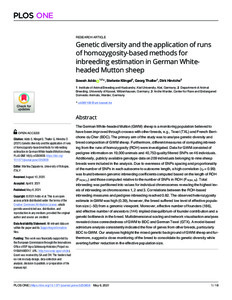| dc.date.accessioned | 2021-11-24T12:46:45Z | |
| dc.date.available | 2021-11-24T12:46:45Z | |
| dc.date.issued | 2021-05-06 | |
| dc.identifier | doi:10.17170/kobra-202110054846 | |
| dc.identifier.uri | http://hdl.handle.net/123456789/13405 | |
| dc.description.sponsorship | Gefördert durch den Publikationsfonds der Universität Kassel | |
| dc.language.iso | eng | |
| dc.rights | Namensnennung 4.0 International | * |
| dc.rights.uri | http://creativecommons.org/licenses/by/4.0/ | * |
| dc.subject.ddc | 630 | |
| dc.title | Genetic diversity and the application of runs of homozygosity-based methods for inbreeding estimation in German Whiteheaded Mutton sheep | eng |
| dc.type | Aufsatz | |
| dcterms.abstract | The German White-headed Mutton (GWM) sheep is a monitoring population believed to have been improved through crosses with other breeds, e.g., Texel (TXL) and French Berrichone du Cher (BDC). The primary aim of the study was to analyse genetic diversity and breed composition of GWM sheep. Furthermore, different measures of computing inbreeding from the runs of homozygosity (ROH) were investigated. Data for GWM consisted of pedigree information on 19,000 animals and 40,753 quality filtered SNPs on 46 individuals.
Additionally, publicly available genotype data on 209 individuals belonging to nine sheep breeds were included in the analysis. Due to evenness of SNPs spacing and proportionality of the number of SNPs in each autosome to autosome length, a high correlation (rp = 0.99) was found between genomic inbreeding coefficients computed based on the length of ROH (FROH_L) and those computed relative to the number of SNPs in ROH (FROH_N). Total inbreeding was partitioned into values for individual chromosomes revealing the highest levels of inbreeding on chromosomes 1, 2 and 3. Correlations between the ROH-based inbreeding measures and pedigree inbreeding reached 0.82. The observed heterozygosity estimate in GWM was high (0.39), however, the breed suffered low level of effective population size (~50) from a genomic viewpoint. Moreover, effective number of founders (186), and effective number of ancestors (144) implied disequilibrium of founder contribution and a genetic bottleneck in the breed. Multidimensional scaling and network visualisation analyses revealed close connectedness of GWM to BDC and German Texel (GTX). A model-based admixture analysis consistently indicated the flow of genes from other breeds, particularly BDC to GWM. Our analyses highlight the mixed genetic background of GWM sheep and furthermore, suggest a close monitoring of the breed to consolidate its genetic diversity while averting further reduction in the effective population size. | eng |
| dcterms.accessRights | open access | |
| dcterms.creator | Addo, Sowah | |
| dcterms.creator | Klingel, Stefanie | |
| dcterms.creator | Thaller, Georg | |
| dcterms.creator | Hinrichs, Dirk | |
| dc.relation.doi | doi:10.1371/journal.pone.0250608 | |
| dc.subject.swd | Fleischschaf | ger |
| dc.subject.swd | Inzucht | ger |
| dc.subject.swd | Biodiversität | ger |
| dc.type.version | publishedVersion | |
| dcterms.source.identifier | eissn:1932-6203 | |
| dcterms.source.issue | 5 | |
| dcterms.source.journal | Plos One | eng |
| dcterms.source.volume | 16 | |
| kup.iskup | false | |
| dcterms.source.articlenumber | e0250608 | |


